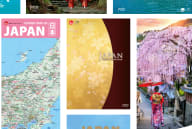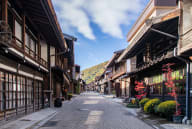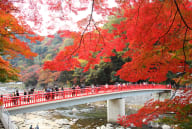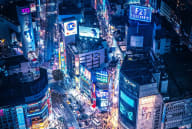It was our third day in the Kansai Region and a day trip to Uji seemed like the perfect interlude before we arrived in the busy city of Osaka.
Uji is the perfect escape from the hustle and bustle of the city. Just a 20-minute train ride from Kyoto if you take the rapid train via the JR Nara Line, it whisks you away to another world—one where you can slow down to hear the rustling of the leaves as the breeze sweeps through; one where tradition in both architecture and cuisine is preserved.
On the train ride out from the city, there were fewer and fewer people on the train until we arrived at the final stop (note: we took the Keihan Railway Uji Line where Uji Station is the terminus stop on the line). The train platform overlooks a field, and once you exit the station, you’re greeted with the historic bridge that was first built in 646. Over the centuries the bridge has been rebuilt time and again, with the latest structure completed in March 1996.

You are greeted by Ujibashi once you exit the train station.
One thing I love about travelling to these cozy cities is that everything is so walkable. Before we exited the station, we grabbed a copy of an illustrated map available for visitors, and this simple guide covers all the prominent sights of the city in an easy-to-follow guide from one side of the shore to the other. Temples, shrines, monuments, and delicious eats await.
Upon crossing the bridge, you’ll see the statue of Murasaki Shikibu, who was a novelist, poet, and lady-in-waiting during the Heian period. It was said that she wrote the world’s first novel between 1000 and 1012 titled The Tale of Genji, which was a depiction of the high courtier lifestyle of the time.
Keep heading down the road to the right of the statue, Byodo-in Omotesando, and you’ll be drawn to every storefront because of the Uji matcha sweets and tea beckoning to you from each shop.
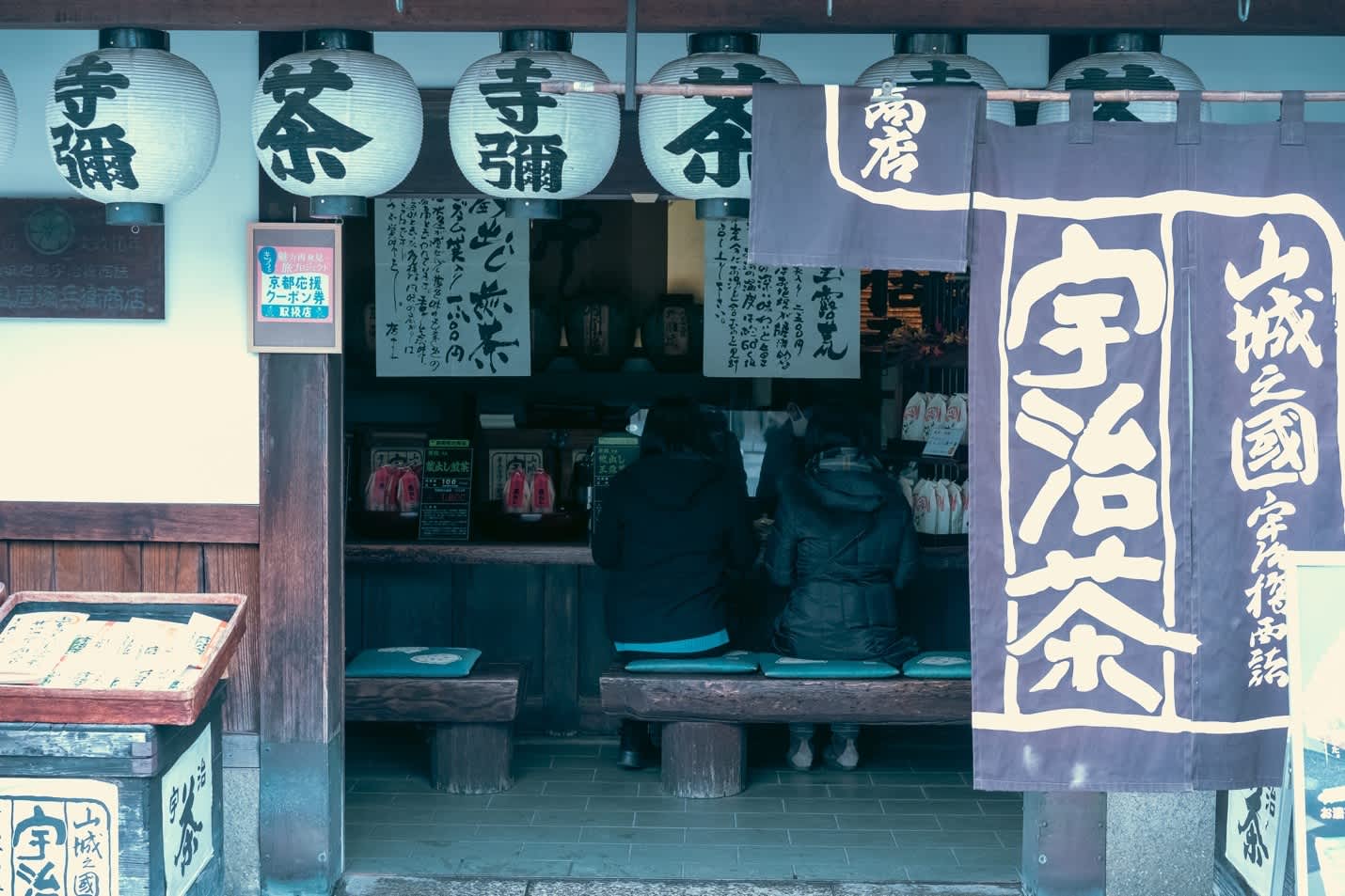
A myriad of tea and dessert shops, and homestyle dining options line the street leading to Byodoin temple.
One thing I love about Japan is how they take the presentation of their food very seriously. I remember when I was on exchange in university, my landlord lady at the time would make wondrous bento boxes that were too pretty to eat! Each time I visit Japan I am in awe of their food’s presentation. Whether your meal costs 1,000 yen or 30,000 yen, the presentation is still immaculate.
As we wandered down the street, we are captivated by the various display models of food in the shop windows. How does a food model make one salivate? It’s something you can experience only in Japan.
It was still early in the day, so we took our time to visit Byodoin, a historic temple embraced by a tranquil garden. You can tell the visitors are quietly admiring the beauty of the place; only murmurs break the silence of the garden. The still winter water reflects the majestic structure.

The serene setting of Byodoin temple will make you want to slow your pace and enjoy this quiet time spent in nature and in the presence of a greater being.
Note that if you would like to visit the Buddha, you can purchase a timed entry ticket to do so. A group of up to 50 people are allowed to visit in each time slot. Photos are not allowed inside the temple. Our host provided a verbal description of the temple in Japanese; while I understood only a portion of the speech, listening to the host reminded me of the beauty of the Japanese language. In every word one can get a sense of the politeness of the spoken word. Although the visit to the temple is just 15 minutes, gazing back out to the garden from inside the temple is another feat to behold.
After exiting the temple, you can continue to visit the museum, where you can see various artefacts that have been well preserved.
After a visit to Byodoin, the best activity is to wander the streets in search of food. There are plenty of choices, and we found that desserts and sweets are the more popular options here, since most people visit for Uji matcha, and matcha has become popular as an ingredient for sweets; this is why you will see Uji matcha soft serve everywhere. We enjoyed a light lunch with udon, pickled dishes, and a bowl of vegetable rice. At other tables we saw guests ordering large matcha parfaits and pancakes, which made us determined to seek our own dessert after our lunch meal.
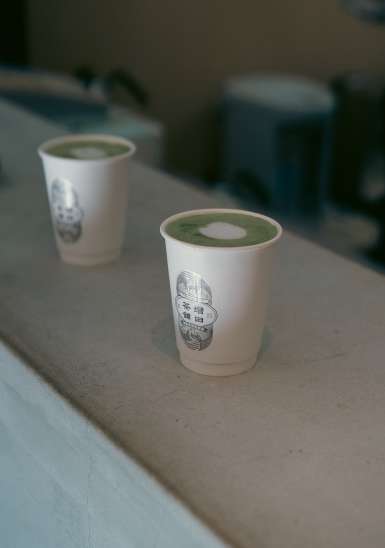
Not only did we enjoy a traditional matcha ceremony, we also tried an Uji matcha latte
Not only did we end up enjoying a traditional matcha and accompanying red bean, mochi and matcha dessert, but we also savoured a hot matcha latte sitting outside under the overcast skies.
After a tasty lunch and sweets, we needed to walk off our meal, so we crossed a short bridge over to Tachibana Island, where you’ll come across Uji Park. If you cross the next bridge over to Tō-no-shima, you’ll be rewarded with a beautiful sight of a waterfall across the way.

To complete a leisurely walking tour, head across the Asagiribashi Bridge, where you can visit the Ujigami-Jinja Shrine. Note that the first, smaller shrine you come across is not the main building. You’ll need to walk a bit further to see the main Sanctuary.
At the shrine, you can get a momento. I got one in the form of a gold rabbit (the shrine is rabbit themed), where you can open the sticker at the bottom and see your fortune.
By this time, it was getting dark, but we had enjoyed a full day of serenity at Uji. To ensure I left with no regrets, I indulged in an Uji matcha soft serve. I couldn’t leave without eating the most famous food. Right?
All in all, there is much to see in Uji, and with even though we spent around five hours doing our walking tour, it still wasn’t enough for us to take in all the sights. If you would like to canvas all the spots in Uji, I would suggest you head out early in the morning to allow for an 8-hour trek around the city. It’ll be a rewarding escape from the city to indulge in traditional experiences, architecture, and cuisine.
Photos: Florence Leung
About the writer
Florence is the Editor in Chief of the lifestyle publication Pendulum Magazine. Rather than just picking up a pen, she also picks up her camera to take photos of culinary, architecture, and travel stories she covers on her globetrotting adventures. Her captures have been featured in publications including Vancouver Sun, The Province, The Londoner and more. Florence lives in Vancouver, Canada.
The opinions expressed in the above article do not reflect the views of JNTO. All content and images are property of the writer unless otherwise specified.


















































